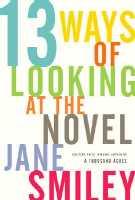Jane Smiley, Thirteen Ways of Looking at the Novel
 Smiley, a novelist, actually has only one way of looking at the novel, but what a way it is! Her definition of the form isolates what she sees as its five fundamental qualities: “lengthy written prose narratives with protagonists.” (She uses the phrase so frequently that I eventually came to abbreviate it mentally as “Le Wripronarp.”) Her analyses of the history, structure, psychology, morality, and craft of the novel integrate the five aspects of her definition beautifully, and she illustrates her points with abundant examples from the more than one hundred novels she read as background for the project.
Smiley, a novelist, actually has only one way of looking at the novel, but what a way it is! Her definition of the form isolates what she sees as its five fundamental qualities: “lengthy written prose narratives with protagonists.” (She uses the phrase so frequently that I eventually came to abbreviate it mentally as “Le Wripronarp.”) Her analyses of the history, structure, psychology, morality, and craft of the novel integrate the five aspects of her definition beautifully, and she illustrates her points with abundant examples from the more than one hundred novels she read as background for the project.Along the way, Smiley discusses similarities in the thematic concerns of many classic novels, common threads that lead her to make the trenchant observation that novels are apparently a way of trying to answer the question of how society ought to treat women. (It sounds ridiculous stated so baldly, but Smiley makes an admirable case for it.) She also describes her experience with writer’s block during the composition of her novel Good Faith, and offers refreshingly unique and encouraging advice on how to draft a novel of your own.
I had only two quarrels with this mostly marvelous compendium. First, Smiley has an eccentrically mathematical approach to explaining a novel’s standard structure (exposition, rising action, climax, denouement). According to Smiley, the exposition should take up the first 10 percent of the text; the rising action should somehow begin to accelerate or refresh at a point about 62 (!) percent of the way through the book; and the climax should come at about the 85- to 90-percent mark.
Second, I think Smiley makes a nearly fatal mistake by devoting the latter 300 pages of this nearly 600-page volume to brief essays on each of the one-hundred-plus books she read as background, arranged in chronological order of the novels’ first publication. The examples she used in the earlier chapters were perfectly chosen and more than sufficient to make her points, so encountering them again in the context of longer descriptions of each book feels redundant and even irritating. Also irritating is the way Smiley seems to lose her objectivity as she progresses from past to present, so that when she gets to novels that were being published during her own career she sometimes seems too eager merely to quibble with them rather than, as with the earlier novels, discussing them in terms of their innovative qualities or their relationships to other works. These choices almost (but not quite) lead Smiley to squander all of the good will she earned from the reader in the book’s first half. The essays could just as easily, and more effectively, have been spun off into a separate book—perhaps a guide for reading groups?
Technorati Tags: Books, Nonfiction, Jane Smiley, Literary Criticism







0 Comments:
Post a Comment
<< Home